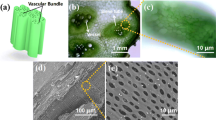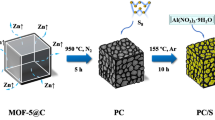Abstract
Reproducible massive biochar with low cost has attracted great attentions due to their potential applications in the future environment and energy. In this work, a nitrogen-doped 3D porous agaric carbon (N-AC) with high specific surface area (1568.2 m2 g−1) was fabricated without adding any activator by using the agaric hydrogel as a precursor. And when employed as a sulfur host, the resulted N-AC–sulfur composite electrode with 60 wt% sulfur content illustrates a high reversible capacity of 875 mAh g−1 at 0.2 C (1 C = 1675 mA g−1) over 100 cycles as well as an excellent rate capability of 620 mAh g−1 at 2 C. Such excellent electrochemical performances could attribute to (1) the conductive carbon skeleton of N-AC that provides rapid electron/ion transfer; (2) abundant pores range from micropores to macropores in N-AC that are beneficial to accommodating the active sulfur and polysulfides and (3) the nitrogen dopants that provide polarized sites in chemical binding of polysulfides. In a word, this work provides a compelling avenue to the design of multifunctional sulfur host for advanced Li–S batteries.








Similar content being viewed by others
References
Bruce PG, Freunberger SA, Hardwick LJ, Tarascon JM (2011) Li–O2 and Li–S batteries with high energy storage. Nat Mater 11:19–29
Younesi R, Veith GM, Johansson P, Edström K, Vegge T (2015) Lithium salts for advanced lithium batteries: Li–metal, Li–O2, and Li–S. Energy Environ Sci 8:1905–1922
Dai H, Xi K, Liu X, Lai C, Zhang S (2018) Cationic surfactant-based electrolyte additives for uniform lithium deposition via lithiophobic repulsion mechanisms. J Am Chem Soc 140:17515–17521
Li C, Li J, Zhang Y, Cui X, Lei H, Li G (2019) Heteroatom-doped hierarchically porous carbons derived from cucumber stem as high-performance anodes for sodium-ion batteries. J Mater Sci 54:5641–5657. https://doi.org/10.1007/s10853-018-03229-2
Gu X, Lai C (2019) One dimensional nanostructures contribute better Li–S and Li–Se batteries: progress, challenges and perspectives. Energy Storage Mater. https://doi.org/10.1016/j.ensm.2019.05.013
Gu X, Tang T, Liu X, Hou Y (2019) Rechargeable metal batteries based on selenium cathodes: progress, challenges and perspectives. J Mater Chem A 7:11566–11583
Yang Y, Zheng G, Cui Y (2013) Nanostructured sulfur cathodes. Chem Soc Rev 42:3018–3032
Walle MD, Zhang Z, Zhang M, You X, Li Y, Liu YN (2018) Hierarchical 3D nitrogen and phosphorous codoped graphene/carbon nanotubes–sulfur composite with synergistic effect for high performance of lithium–sulfur batteries. J Mater Sci 53:2685–2696. https://doi.org/10.1007/s10853-017-1678-1
Duan L, Zhao L, Cong H, Zhang X, Lu W, Xue C (2019) Plasma treatment for nitrogen-doped 3D graphene framework by a conductive matrix with sulfur for high-performance Li–S batteries. Small 15:1804347–1804354
Ji X, Lee KT, Nazar LF (2009) A highly ordered nanostructured carbon–sulphur cathode for lithium–sulphur batteries. Nat Mater 8:500–506
Liang S, Liang C, Xia Y et al (2016) Facile synthesis of porous Li2S@C composites as cathode materials for lithium–sulfur batteries. J Power Sources 306:200–207
Cheng XB, Huang JQ, Zhang Q, Peng HJ, Zhao MQ, Wei F (2014) Aligned carbon nanotube/sulfur composite cathodes with high sulfur content for lithium–sulfur batteries. Nano Energy 4:65–72
Zhang C, Wu HB, Yuan C, Guo Z, Lou XWD (2012) Confining sulfur in double-shelled hollow carbon spheres for lithium-sulfur batteries. Angew Chem Int Ed Engl 124:9730–9733
Zhou G, Li L, Ma C et al (2015) A graphene foam electrode with high sulfur loading for flexible and high energy Li–S batteries. Nano Energy 11:356–365
Zhang J, Cai Y, Zhong Q, Lai D, Yao J (2015) Porous nitrogen-doped carbon derived from silk fibroin protein encapsulating sulfur as a superior cathode material for high-performance lithium–sulfur batteries. Nanoscale 7:17791–17797
Song RS, Wang B, Ruan TT et al (2018) A three-dimensional cathode matrix with bi-confinement effect of polysulfide for lithium–sulfur battery. Appl Surf Sci 472:396–404
Gu X, Xin L, Li Y, Dong F, Fu M, Hou Y (2018) Highly reversible Li–Se batteries with ultra-lightweight N, S-codoped graphene blocking layer. Nano-Micro Lett 10:59–68
Gu X, Wang Y, Lai C et al (2015) Microporous bamboo biochar for lithium–sulfur batteries. Nano Res 8:129–139
Yang K, Gao Q, Tan Y et al (2016) Biomass-derived porous carbon with micropores and small mesopores for high-performance lithium-sulfur batteries. Chem Eur J 22:3239–3244
Zhang Y, Zhao Y, Konarov A, Li Z, Chen P (2015) Effect of mesoporous carbon microtube prepared by carbonizing the poplar catkin on sulfur cathode performance in Li/S batteries. J Alloys Compd 619:298–302
Zhao S, Li C, Wang W et al (2013) A novel porous nanocomposite of sulfur/carbon obtained from fish scales for lithium–sulfur batteries. J Mater Chem A 1:3334–3339
Yao H, Zheng G, Li W et al (2013) Crab shells as sustainable templates from nature for nanostructured battery electrodes. Nano Lett 13:3385–3390
Wei S, Zhang H, Huang Y, Wang W, Xia Y, Yu Z (2011) Pig bone derived hierarchical porous carbon and its enhanced cycling performance of lithium–sulfur batteries. Energy Environ Sci 4:736–740
Yuan H, Liu T, Liu Y et al (2019) A review of biomass materials for advanced lithium–sulfur batteries. Chem Sci 10:7484–7495
Gu X, Lai C, Liu F, Yang W, Hou Y, Zhang S (2015) A conductive interwoven bamboo carbon fiber membrane for Li–S batteries. J Mater Chem A 3:9502–9509
Zhao Q, Zhu Q, An Y et al (2018) A 3D conductive carbon interlayer with ultrahigh adsorption capability for lithium-suflur batteries. Appl Surf Sci 440:770–777
Li D, Chang G, Zong L et al (2019) From double-helix structured seaweed to S-doped carbon aerogel with ultra-high surface area for energy storage. Energy Storage Mater 17:22–30
Zhu Z, Liu Y, Ju Z et al (2019) Synthesis of diverse green carbon nanomaterials through fully utilizing biomass carbon source assisted by KOH. ACS Appl Mater Interfaces 11:24205–24211
Ma J, Qiao Z, Xiang X (2011) Optimisation of extraction procedure for black fungus polysaccharides and effect of the polysaccharides on blood lipid and myocardium antioxidant enzymes activities. Carbohydr Polym 84:1061–1068
Zhu X, Xu Y, Li D, Zhao N, Gong J (2018) Correlation of the antioxidant activity and of polysaccharides from auricularia auricula with its molecular weight and extracting agent properties. Mod Food Sci Technol 34:59–67
Gu X, Tong CJ, Rehman S, Liu LM, Hou Y, Zhang S (2016) Multifunctional nitrogen-doped loofah sponge carbon blocking layer for high-performance rechargeable lithium batteries. ACS Appl Mater Interfaces 8:15991–16001
Gu X, Tong CJ, Lai C et al (2015) Porous nitrogen and phosphorous dual doped graphene blocking layer for high performance Li–S batteries. J Mater Chem A 3:16670–16678
Lai C, Wu Z, Gu X et al (2015) Reinforced conductive confinement of sulfur for robust and high-performance lithium–sulfur batteries. ACS Appl Mater Interfaces 7:23885–23892
Liang C, Liang S, Xia Y et al (2017) H2O-induced self-propagating synthesis of hierarchical porous carbon: a promising lithium storage material with superior rate capability and ultra-long cycling life. J Mater Chem A 5:18221–18229
Liang C, Liang S, Xia Y et al (2018) Synthesis of hierarchical porous carbon from metal carbonates towards high-performance lithium storage. Green Chem 20:1484–1490
Hencz L, Gu X, Zhou X, Martens W, Zhang S (2017) Highly porous nitrogen-doped seaweed carbon for high-performance lithium–sulfur batteries. J Mater Sci 52:12336–12347. https://doi.org/10.1007/s10853-017-1288-y
Zhong Y, Chao D, Deng S et al (2018) Confining sulfur in integrated composite scaffold with highly porous carbon fibers/vanadium nitride arrays for high-performance lithium-sulfur batteries. Adv Funct Mater 28:1706391–1706399
Peng HJ, Xu WT, Zhu L et al (2016) 3D carbonaceous current collectors: the origin of enhanced cycling stability for high-sulfur-loading lithium–sulfur batteries. Adv Funct Mater 26:6351–6358
Rehman S, Gu X, Khan K et al (2016) 3D vertically aligned and interconnected porous carbon nanosheets as sulfur immobilizers for high performance lithium–sulfur batteries. Adv Energy Mater 6:1502518
Li GR, Ling M, Ye YF et al (2015) Acacia senegal-inspired bifunctional binder for longevity of lithium-sulfur batteries. Adv Energy Mater 5:1500878–1500885
Huang M, Yang J, Xi B et al (2018) Enhancing kinetics of Li–S batteries by graphene-like N, S-codoped biochar fabricated in NaCl non-aqueous ionic liquid. Sci China Mater 62:455–464
Pang Q, Tang J, Huang H et al (2015) A nitrogen and sulfur dual-doped carbon derived from polyrhodanine@cellulose for advanced lithium–sulfur batteries. Adv Mater 27:6021–6028
Liu QC, Xu JJ, Xu D, Zhang XB (2015) Flexible lithium–oxygen battery based on a recoverable cathode. Nat Commun 6:7892–7899
Liao F, Światowska J, Maurice V et al (2014) Ageing mechanisms of conversion-type electrode material studied on iron sulfide thin films. Electrochim Acta 120:359–368
Eshetu GG, Judez X, Li C et al (2017) Lithium azide as an electrolyte additive for all-solid-state lithium–sulfur batteries. Angew Chem Int Ed Engl 56:15368–15372
Sun Y, Li Y, Sun J, Li Y, Pei A, Cui Y (2017) Stabilized Li3N for efficient battery cathode prelithiation. Energy Storage Mater 6:119–124
Ma JL, Bao D, Shi M-M, Yan JM, Zhang XB (2017) Reversible nitrogen fixation based on a rechargeable lithium–nitrogen battery for energy storage. Chem 2:525–532
Pei F, Lin L, Fu A et al (2018) A two-dimensional porous carbon-modified separator for high-energy-density Li–S batteries. Joule 2:323–336
Acknowledgements
This work was supported by the National Natural Science Foundation of China (No. 51902036, 51808080), Natural Science Foundation of Chongqing Science & Technology Commission (No. cstc2019jcyj-msxm1407), the Venture & Innovation Support Program for Chongqing Overseas Returnees (Grant No. CX2018129), the Science and Technology Research Program of Chongqing Municipal Education Commission (Grant No. KJQN201800808), the Start-up Foundation of High-level Talents in Chongqing Technology and Business University (Grant No.1856008) and Open Research Fund of Chongqing Key Laboratory of Catalysis and New Environmental Materials (Grant No. KFJJ2018082). Dr. Liu also wanted to thank the financial support from the Engineering and Physical Sciences Research Council (EPSRC) (Grant No. EP/S032886/1).
Author information
Authors and Affiliations
Corresponding authors
Additional information
Publisher's Note
Springer Nature remains neutral with regard to jurisdictional claims in published maps and institutional affiliations.
Electronic supplementary material
Below is the link to the electronic supplementary material.
Rights and permissions
About this article
Cite this article
Gu, X., Li, H., Wen, H. et al. From agaric hydrogel to nitrogen-doped 3D porous carbon for high-performance Li–S batteries. J Mater Sci 55, 1136–1147 (2020). https://doi.org/10.1007/s10853-019-03999-3
Received:
Accepted:
Published:
Issue Date:
DOI: https://doi.org/10.1007/s10853-019-03999-3




